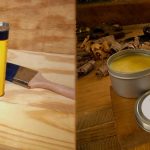How To Paint Over Polyurethane – Pros And Cons
Many woodworkers use polyurethane as a wood finish because of its durability, water resistance, and glossy look. However, the downside to using polyurethane is its glossy, plastic-like surface makes it hard for paint to adhere.
Now, wondering how to paint over polyurethane? Start by cleaning and sanding the surface prior to applying a suitable paint primer. Choose a suitable type of paint and mix and thin it appropriately before applying it on the surface. Add as many coats of paint as needed to achieve your desired finish.
Read on to learn about how to paint over polyurethane, which types of paint are suitable, and a few tips to keep you safe while you paint.
Tools And Materials Needed To Paint Over Polyurethane
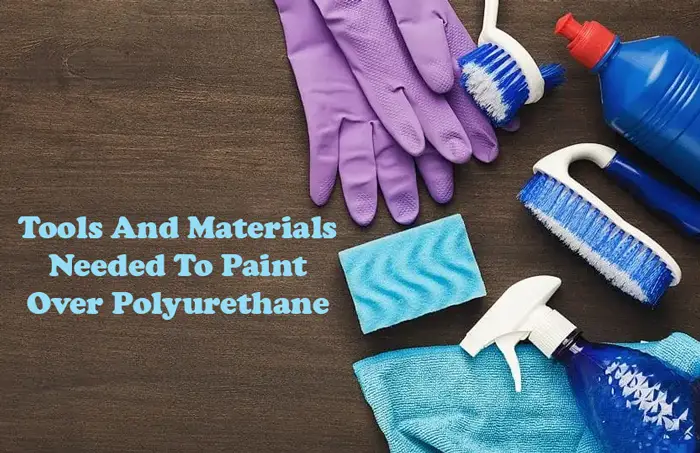
You will need the following tools and materials to paint over polyurethane;
- Sandpaper or sanding blocks or sanding machine
- A wood cleaner like trisodium phosphate solution
- Primer
- Paint
- Paintbrush or roller
- Cotton cloth or lint-free rags
- Painters’ tape
- Paint bucket or tray
- Paint thinner or mineral spirits
- Drop cloth
- Safety goggles
- Respiratory mask
- Stir sticks
- Gloves
- Protective clothing
How To Paint Over Polyurethane – Step-By-Step Guide
When painting over polyurethane, it’s important to use the correct techniques to ensure a smooth and durable finish. But before you start painting, gather all the supplies listed above. Follow the guide below for the best results when painting over polyurethane.
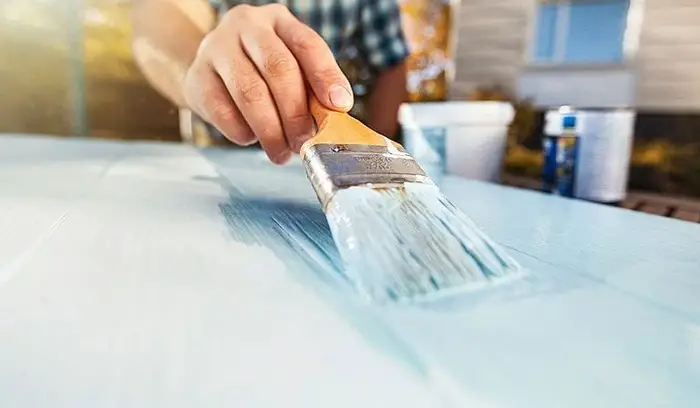
Step 1: Prepare the polyurethane surface
It’s important to prepare the polyurethane surface before painting to ensure the paint can adhere to it. Follow the steps below to prepare the surface;
- Use a clean cotton cloth or lint-free rag with your chosen wood cleaner (e.g., TSP solution) to wipe the polyurethane surface. Clean thoroughly to remove any accumulated dirt, wax, grease, or debris.
- Lightly sand the surface with fine-grit sandpaper to roughen it so it’s easy for the paint to adhere. Ensure you wipe the surface after sanding to remove all the dust.
- If the surface is too big to sand by hand, you can use liquid sandpaper to roughen the polyurethane surface.
- Fill any scratches or dents with wood filler. Wait until the filler dries, then sand the surface to achieve uniform smoothness.
Step 2: Apply the primer
Select a type of primer designed for glossy and non-porous surfaces and apply it evenly over the polyurethane surface. Oil-based primers are the most suitable type of primer for polyurethane. Always follow the manufacturer’s instructions when applying the primer.
Step 3: Choose a suitable type of paint
Ensure you have the right paint for use over polyurethane. Types of paint you can use over polyurethane include acrylic, oil-based, and latex paint. Depending on your preference, the paint you choose may be matte or enamel and of a color that matches your decor.
Step 4: Apply the paint
Before applying the paint, pour it into a bucket or tray and stir it vigorously and thoroughly. If you use oil paint, add thinner or mineral spirits to thin the paint and achieve the best viscosity.
Follow the steps below to apply a coat of paint on the polyurethane finish;
- Pick the correct tools depending on the type of paint you’re applying to prevent uneven paint spread.
- Dip the brush or roller into the paint bucket to load it. Tap the brush against the bucket to get rid of excess paint.
- Push the paintbrush in one direction to achieve long, smooth strokes and a neat finish.
- Paint small areas at a time and ensure your strokes overlap to avoid lap marks.
- Apply a thin coat of paint. Thick layers are less durable than thin ones because they’re susceptible to peeling.
- Always allow a paint coat to dry before applying a new one. If you’re unsure how long a coat should dry, refer to the manufacturer’s instructions.
Step 5: Final touches
Once you’ve applied the final coat of paint, allow it to dry, and then apply a paint sealer to enhance its durability.
What Paint Is Suitable For Painting Over Polyurethane
When planning to paint over a polyurethane finish, selecting a paint that will adhere well to the finish’s glossy and non-porous surface is important. The most common types of paint used over polyurethane are;
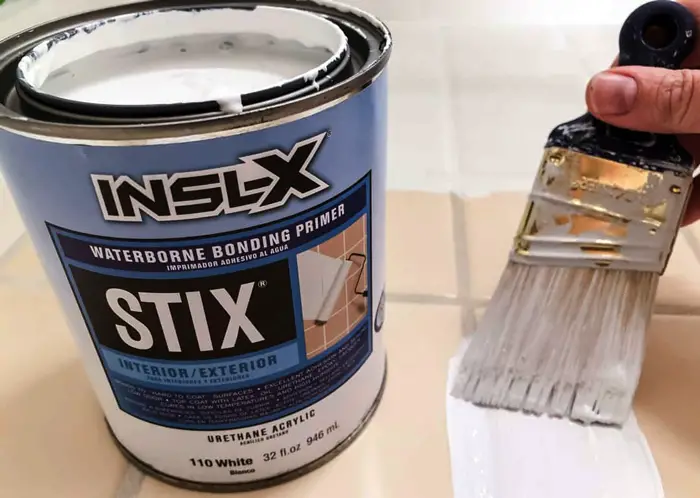
1. Oil-based paint
Most painters use oil-based paint on polyurethane surfaces because of its high quality and durability. Oil-based paint adheres well to surfaces coated with polyurethane and requires fewer coats to achieve maximum coverage.
Despite their many merits, oil-based paints take a long time to dry and produce strong, smelly fumes during application. These paints also contain high levels of volatile organic compounds that may cause lung damage when inhaled.
2. Acrylic paints
Acrylic paints dry quickly, adhere well to polyurethane surfaces and provide great durability and moisture resistance. Since these paints don’t require organic solvents, they generally have low volatile organic compounds.

3. Latex paints
Since latex paints are water-based, they dry quickly, are easy to clean, and emit less fumes than oil paints. However, latex paints are less durable than oil paints and cannot adhere to polyurethane without a primer.
What Are The Merits And Demerits Of Painting Over Polyurethane?
Painting over polyurethane can be advantageous in certain situations, but it also has some demerits. Common merits and demerits of painting over polyurethane include;
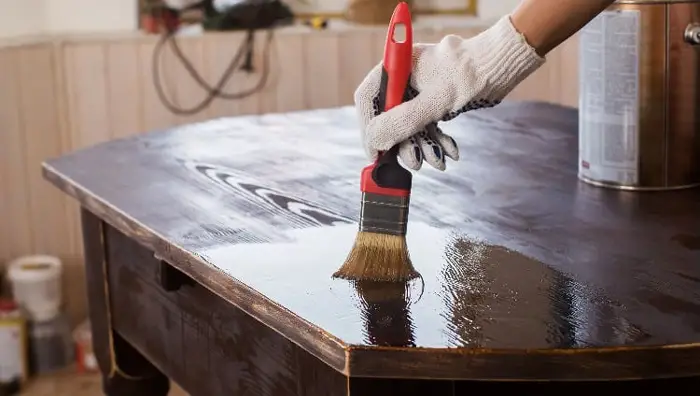
Merits
- Saves time that would have otherwise been wasted sanding the whole surface
- It helps save money
- It’s a convenient way to rejuvenate surfaces that have accumulated scratches
- The polyurethane layer that remains under the new paint coat provides an extra layer of protection, hence increasing durability
Demerits
- Applying a primer takes a lot of time
- Since polyurethane surfaces are smooth and glossy, it can be difficult for new paint to adhere
- Some paints may turn yellow over time due to reacting with the polyurethane finish
- The toxic fumes released during painting can cause respiratory issues
Safety Guidelines When Painting Over Polyurethane
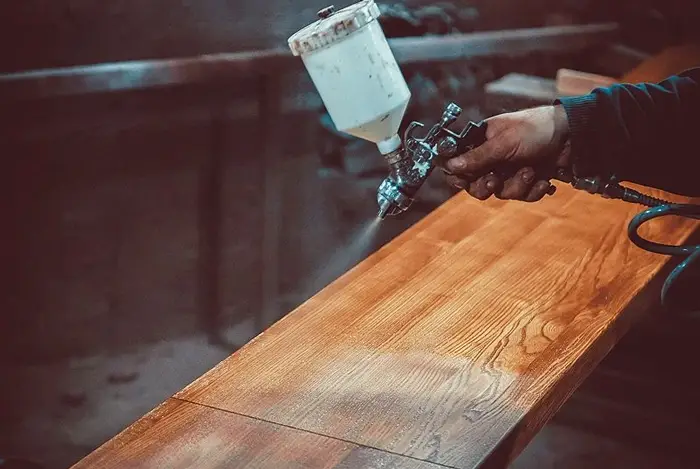
Safety is important when painting, especially if you’re using oil-based paint. Here are a few tips that will help keep you from harm’s way;
- Read and follow all the instructions and safety guidelines on the paint can labels
- Avoid smoking while painting. Most types of paint are flammable, so lighting a cigarette while painting may cause dangerous fires
- Always wear protective clothing such as gloves and respiratory masks
- If you’re not working outside, ensure you’re working in a well-ventilated room with open windows and doors to allow free air circulation
- Keep children and pets away from your work area to avoid problems like accidental ingestion or exposure to harmful chemicals
- Dispose of leftover paint and used materials like paint brushes and cans properly, following local regulations
FAQs
Here are some answers to common questions about painting over polyurethane.
Q: Can I use chalk paint over polyurethane?
Yes. Since chalk paint’s qualities enable it to easily stick to most surfaces, you can use it over polyurethane. To achieve the best result, prepare the surface by cleaning and sanding it lightly. Once you finish applying the chalk paint, add a sealant according to the manufacturer’s instructions.
Q: Do you always have to sand polyurethane before painting over it?
Not necessarily, but sanding is important because it makes the polyurethane surface rough enough for the paint to adhere properly. However, if you use a paint and primer designed for glossy surfaces, you won’t need to sand the polyurethane surface.
Q: Do I need to sand polyurethane after using a deglosser?
No, you don’t need to sand after applying a deglosser. It has the same effect as sanding because it makes the polyurethane surface rough enough for the paint to stick.
Conclusion
In summary, painting over polyurethane is a relatively straightforward process. Begin by cleaning and sanding the surface before applying the primer. Lay the paint in thin layers and add as many coats as needed to achieve your desired aesthetic before applying a paint sealant.
Using the right types of paint over polyurethane is important to avoid peeling and yellowing and ensure durability. Always wear protective gear like gloves, goggles, and respiratory masks, work in well-ventilated rooms, and keep children away while painting.




